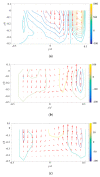Large-Scale Flow in Micro Electrokinetic Turbulent Mixer
- PMID: 32872223
- PMCID: PMC7570105
- DOI: 10.3390/mi11090813
Large-Scale Flow in Micro Electrokinetic Turbulent Mixer
Abstract
In the present work, we studied the three-dimensional (3D) mean flow field in a micro electrokinetic (μEK) turbulence based micromixer by micro particle imaging velocimetry (μPIV) with stereoscopic method. A large-scale solenoid-type 3D mean flow field has been observed. The extraordinarily fast mixing process of the μEK turbulent mixer can be primarily attributed to two steps. First, under the strong velocity fluctuations generated by μEK mechanism, the two fluids with different conductivity are highly mixed near the entrance, primarily at the low electric conductivity sides and bias to the bottom wall. Then, the well-mixed fluid in the local region convects to the rest regions of the micromixer by the large-scale solenoid-type 3D mean flow. The mechanism of the large-scale 3D mean flow could be attributed to the unbalanced electroosmotic flows (EOFs) due to the high and low electric conductivity on both the bottom and top surface.
Keywords: micro electrokinetic (μEK) turbulence; three-dimensional mean flow field; turbulent mixer; unbalanced electroosmotic flow.
Conflict of interest statement
The authors declare no conflict of interest.
Figures










References
-
- Kang K.K., Lee B., Lee C.S. Microfluidic approaches for the design of functional materials. Microelectron. Eng. 2018;199:1–15. doi: 10.1016/j.mee.2018.07.007. - DOI
-
- Sun B., Jiang J., Shi N., Xu W. Application of microfluidics technology in chemical engineering for enhanced safety. Process. Saf. Prog. 2016;35:365–373. doi: 10.1002/prs.11801. - DOI
-
- Wang F. Research Progress of Microfluidic Chips Preparation and its Optical Element. Sens. Transducers. 2014;166:29–38.
Grants and funding
LinkOut - more resources
Full Text Sources

